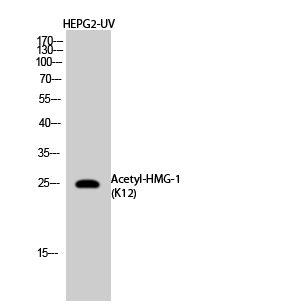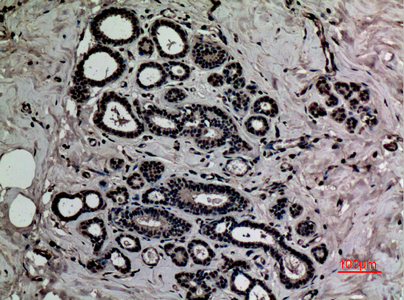HMG-1 (Acetyl Lys12) Polyclonal Antibody
- Catalog No.:YK0060
- Applications:WB;IHC;IF;ELISA
- Reactivity:Human;Mouse;Rat
- Target:
- HMGB1
- Fields:
- >>Base excision repair;>>Autophagy - animal;>>Necroptosis;>>Neutrophil extracellular trap formation
- Gene Name:
- HMGB1
- Protein Name:
- High mobility group protein B1
- Human Gene Id:
- 3146
- Human Swiss Prot No:
- P09429
- Mouse Gene Id:
- 100862258
- Mouse Swiss Prot No:
- P63158
- Rat Gene Id:
- 25459
- Rat Swiss Prot No:
- P63159
- Immunogen:
- Synthesized acetyl-peptide derived from the N-terminal region of human HMG-1 around the acetylation site of K12.
- Specificity:
- Acetyl-HMG-1 (K12) Polyclonal Antibody detects endogenous levels of HMG-1 protein only when acetylation at K12.
- Formulation:
- Liquid in PBS containing 50% glycerol, 0.5% BSA and 0.02% sodium azide.
- Source:
- Polyclonal, Rabbit,IgG
- Dilution:
- WB 1:500 - 1:2000. IHC: 1:100-300 ELISA: 1:10000.. IF 1:50-200
- Purification:
- The antibody was affinity-purified from rabbit antiserum by affinity-chromatography using epitope-specific immunogen.
- Concentration:
- 1 mg/ml
- Storage Stability:
- -15°C to -25°C/1 year(Do not lower than -25°C)
- Other Name:
- HMGB1;HMG1;High mobility group protein B1;High mobility group protein 1;HMG-1
- Observed Band(KD):
- about 30kd
- Background:
- This gene encodes a protein that belongs to the High Mobility Group-box superfamily. The encoded non-histone, nuclear DNA-binding protein regulates transcription, and is involved in organization of DNA. This protein plays a role in several cellular processes, including inflammation, cell differentiation and tumor cell migration. Multiple pseudogenes of this gene have been identified. Alternative splicing results in multiple transcript variants that encode the same protein. [provided by RefSeq, Sep 2015],
- Function:
- function:Binds preferentially single-stranded DNA and unwinds double stranded DNA.,similarity:Belongs to the HMGB family.,similarity:Contains 2 HMG box DNA-binding domains.,
- Subcellular Location:
- Nucleus . Chromosome . Cytoplasm . Secreted . Cell membrane ; Peripheral membrane protein ; Extracellular side . Endosome . Endoplasmic reticulum-Golgi intermediate compartment . In basal state predominantly nuclear. Shuttles between the cytoplasm and the nucleus (PubMed:12231511, PubMed:17114460). Translocates from the nucleus to the cytoplasm upon autophagy stimulation (PubMed:20819940). Release from macrophages in the extracellular milieu requires the activation of NLRC4 or NLRP3 inflammasomes (By similarity). Passively released to the extracellular milieu from necrotic cells by diffusion, involving the fully reduced HGMB1 which subsequently gets oxidized (PubMed:19811284). Also released from apoptotic cells (PubMed:16855214, PubMed:18631454). Active secretion from a variety of immune a
- Expression:
- Ubiquitous. Expressed in platelets (PubMed:11154118).
- June 19-2018
- WESTERN IMMUNOBLOTTING PROTOCOL
- June 19-2018
- IMMUNOHISTOCHEMISTRY-PARAFFIN PROTOCOL
- June 19-2018
- IMMUNOFLUORESCENCE PROTOCOL
- September 08-2020
- FLOW-CYTOMEYRT-PROTOCOL
- May 20-2022
- Cell-Based ELISA│解您多样本WB检测之困扰
- July 13-2018
- CELL-BASED-ELISA-PROTOCOL-FOR-ACETYL-PROTEIN
- July 13-2018
- CELL-BASED-ELISA-PROTOCOL-FOR-PHOSPHO-PROTEIN
- July 13-2018
- Antibody-FAQs
- Products Images

- Western Blot analysis of HepG2 cells treated with UV using Acetyl-HMG-1 (K12) Polyclonal Antibody. Antibody was diluted at 1:1000. Secondary antibody(catalog#:RS0002) was diluted at 1:20000

- Immunohistochemical analysis of paraffin-embedded human-breast, antibody was diluted at 1:100
.jpg)
- Immunohistochemical analysis of paraffin-embedded human-brain, antibody was diluted at 1:100



